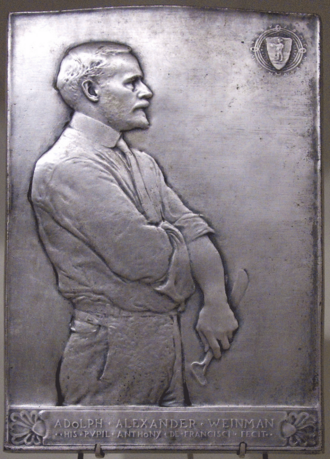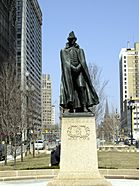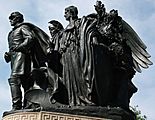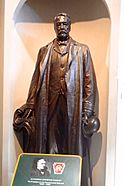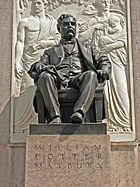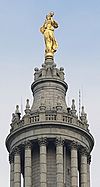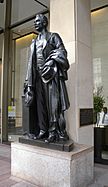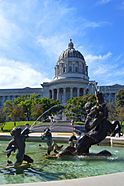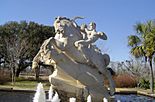Adolph Alexander Weinman facts for kids
Quick facts for kids
Adolph Alexander Weinman
|
|
|---|---|
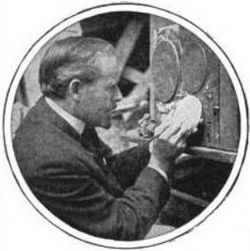
Adolph Weinman, c. 1917
|
|
| Born | December 11, 1870 Durmersheim, Baden, Germany
|
| Died | August 8, 1952 (aged 81) Port Chester, New York, U.S.
|
| Nationality | German-American |
| Education | |
| Known for | Sculpture |
Adolph Alexander Weinman (born December 11, 1870 – died August 8, 1952) was a famous American sculptor. He was born in Germany but moved to the United States when he was a teenager. He is best known for designing some of the most beautiful coins in U.S. history.
Contents
Becoming a Sculptor
Adolph Alexander Weinman was born in a town called Durmersheim, near Karlsruhe, Germany. When he was 14 years old, in 1885, he moved to the United States.
At just 15, he started taking art classes in the evenings at a school called Cooper Union. Later, he studied at the Art Students League of New York. He learned from very famous sculptors like Augustus Saint-Gaudens and Philip Martiny.
His Amazing Career
Before starting his own art studio in 1904, Weinman worked as an assistant to other sculptors. Even though many people remember him for his coin designs, he thought of himself as an "architectural sculptor." This means he created sculptures that were part of buildings. He made a steady income by selling smaller copies of his bigger artworks. One famous example is Descending Night, which was first made for a big exhibition in San Francisco in 1915.
Weinman was a very important artist in his time. He was the president of the National Sculpture Society from 1927 to 1930. His art was even part of the art competition at the 1928 Summer Olympics! He also served on the U.S. Commission of Fine Arts, which advises the government on art. He was a member of many other important art groups too.
Later Life and Legacy
Weinman passed away in Port Chester, New York, on August 8, 1952. He was buried in Calvary Cemetery in Queens. His important papers and drawings are kept at the Smithsonian Archives of American Art.
Adolph Weinman's family also had artistic talent. His son, Robert Weinman, became a sculptor too. Another son, Howard Weinman, designed a special coin called the Long Island Tercentenary half dollar.
Famous Works
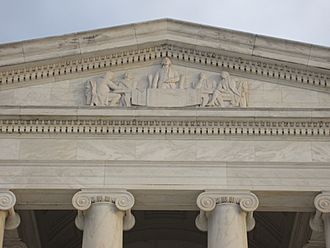
Even though he loved architectural sculpture, Weinman is most famous for designing two of America's most beautiful coins:
- The Walking Liberty Half Dollar: This design is now used on the front of the American Silver Eagle coin.
- The "Mercury" dime: This coin was made for many years.
He also designed several medals for the United States Armed Forces, like the Asiatic-Pacific Campaign Medal. A famous model named Audrey Munson posed for many of Weinman's sculptures.
Weinman's architectural sculptures can be seen on important buildings like the state capitols of Wisconsin, Missouri, and Louisiana. He often worked with a famous architecture company called McKim, Mead, and White. He designed sculptures for their buildings in New York City, including the Manhattan Municipal Building and the old Pennsylvania Station. Sadly, when Penn Station was torn down in 1963, some of his beautiful angel sculptures were lost. However, two of his eagle sculptures were saved and are now outside the new Penn Station.
You can also find his work on the Elks National Veterans Memorial in Chicago, and inside the Supreme Court of the United States building in Washington, D.C.. He also created the large sculpture on the front of the Jefferson Memorial in Washington, D.C.
Some of his other artworks include monuments in Detroit and a statue of Abraham Lincoln in Hodgenville, Kentucky.
Weinman's sculptures often have a graceful, classical style. His figures usually wear flowing clothes, but his work also shows hints of the Art Deco style that became popular later.
He also taught art, and one of his students was Eleanor Mary Mellon.
Selected Sculptures
- General Alexander Macomb (1906–1908), Detroit, Michigan.
- Union Soldiers and Sailors Monument (1909), Baltimore, Maryland.
- Abraham Lincoln (1909), Hodgenville, Kentucky.
- Alexander Johnston Cassatt (1910), at the old Pennsylvania Station, New York City.
- Abraham Lincoln (1911), Kentucky State Capitol, Frankfort, Kentucky.
- William Cotter Maybury Memorial (1912), Detroit, Michigan.
- Rising Sun (1914–15), Panama–Pacific International Exposition, San Francisco, California.
- Descending Night (1914–15), Panama–Pacific International Exposition, San Francisco, California.
- Samuel Rea (1926), at the old Pennsylvania Station, New York City.
- Fountain of the Centaurs (around 1926), Missouri State Capitol, Jefferson City, Missouri.
- Pair of Lions (1929–30), Baltimore Museum of Art, Baltimore, Maryland.
- Dewitt Clinton (1941) and Alexander Hamilton (1941), Museum of the City of New York.
- Riders of the Dawn (around 1942), Brookgreen Gardens, South Carolina.
-
General Alexander Macomb (1906–1908),
Detroit, Michigan -
Union Soldiers and Sailors Monument (1909), Wyman Park
Baltimore, Maryland -
Alexander Johnston Cassatt (1910), Pennsylvania Station
New York City -
William Cotter Maybury Memorial (1912), Grand Circus Park,
Detroit, Michigan
-
Civic Fame (1913), atop Manhattan Municipal Building,
New York City -
Samuel Rea (1926), Pennsylvania Station,
New York City. -
Fountain of the Centaurs, detail (ca. 1926), Missouri State Capitol,
Jefferson City, Missouri -
Riders of the Dawn (ca. 1942), Brookgreen Gardens,
Murrells Inlet, South Carolina -
One of the four Adolf Weinman eagles of the Prison Ship Martyrs' Monument
-
One of four bronze eagle sculptures surrounding the Prison Ship Martyrs' Monument in the Fort Greene Historic District
Architectural Sculptures
- Sculptures for Pennsylvania Station (1903–04), New York City (demolished 1964). Some pieces were saved!
- Sculptures for Madison Square Presbyterian Church (1904–1906), New York City (demolished 1919).
- Sculptures for the Prison Ship Martyrs' Monument (1908), Brooklyn, New York City.
- Masonic Sphinxes: Power and Wisdom (1911–1915), House of the Temple, Washington, D.C.
- Sculptures for the Manhattan Municipal Building (1913–1915), New York City.
- Bronze doors (1921–1923), American Academy of Arts and Letters building, New York City.
- Sculptures for the Elks National Veterans Memorial (1924–1926), Chicago, Illinois.
- South Pediment sculpture (around 1926), Missouri State Capitol, Jefferson City, Missouri.
- Destiny Pediment (1935), National Archives Building, Washington, D.C.
- Drafting the Declaration of Independence (1939–1943), a large sculpture on the front of the Jefferson Memorial, Washington, D.C.
-
Pennsylvania Station, New York City (1903–04, demolished 1964)
-
Eagle, National Zoo, Washington, D.C. Salvaged from Pennsylvania Station,
New York City -
Eagle (1908), one of four that decorated the Prison Ship Martyrs' Monument
Brooklyn, New York City -
Wisdom Sphinx (1911–1915), House of the Temple,
Washington, D.C. -
Spandrel figure (1923), First National Bank Building,
Davenport, Iowa -
Destiny Pediment (1935), National Archives Building,
Washington, D.C. -
Drafting the Declaration of Independence Pediment (1939–1943), Jefferson Memorial,
Washington, D.C.
U.S. Coins and Medals
- Mercury dime (1916–1945): Billions of these dimes were made! The design is now used on the American Palladium Eagle coin.
- Walking Liberty half dollar (1916–1947): This design is now used on the American Silver Eagle coin.
- J. Sanford Saltus Medal Award: Weinman was the second person to receive this special medal from the American Numismatic Society, which studies coins and medals.


